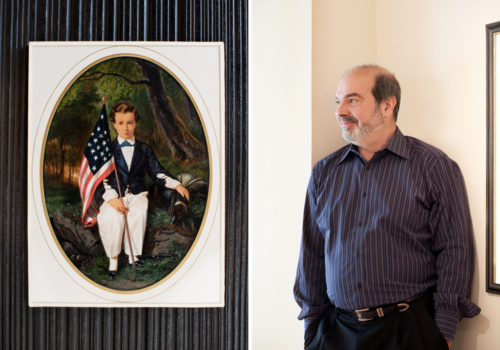Day 11
I know, it has nothing to do with photography, but Charles Isaacs, whom I met today, lives and exposes upstairs from the Manolo Blahnik boutique across the street from MoMA. I didn’t have time to visit the Cindy Sherman exhibition, but like a good New Yorker, I did have time to peek in the window at a few pair of shoes.
When I arrive at Charles’s home, the amazement continues as I put my belongings on the counter next to his antique Asian jades. Slightly farther away, pre-Raphaelite masks seem to be in quiet contemplation. The place is overcrowded, Charles explains, because he’s getting ready for AIPAD in a few days. A nice mess.
Our conversation took off instantly . Charles is fascinating, funny, and composed. I felt as if I was in a movie theater, and his individual experience let me relive all of the anecdotes that I had heard since the beginning of this project. I was seeing the history of photography before my eyes. He adds a little postscript to the history of contemporary photography. He thinks that photography today is lacking direction – that today’s world is more attached to the form of the picture than to what it actually depicts. He fears that photography will forget its fundamental goal: showing who we are and where we come from. Fascinating – more to come.
A final anecdote about this encounter: Charles and I had a 19th century French vocabulary battle… “Colodion negative on white glass colored by hand” translates by “négatif au collodion sur verre blanc coloré à la main.” And “Albumen print from a wet collodion negative” means “tirage albuminé de plaque de négatif au collodion humide”. Charles won. It wasn’t even close. Thanks anyway to all of my friends and colleagues at the International Center of Photography who tried to help me…
And thank you Charles.
From the first encounter with photography to the opening of his own space…
Charles explains how he was shy as a young boy. He loved taking pictures, but what he especially liked about photography was that it let him meet people and overcome the social pressures he felt.
After graduating in 1973, he worked freelance for his college before focusing on the refugee camps that were created in the States following the Vietnam war. He was lucky enough to get to show his work to Cornell Capa, who invited him for his first exhibition at the International Center of Photography.
He was then hired by the Philadelphia Inquirer (a major daily that at the time won a Pulitzer Prize nearly every year) where he would work as a photographer for 10 years.
His salary enabled him to buy some photographs and, like many, he began his collection with an Ansel Adams. “Undoubtedly a Moonrise or something like that,” he adds.
But quite quickly his interests shifted to older photography, so he sold his first purchases and bought works by Talbot and Baldus. He started working as an art dealer and became a member of AIPAD in 1985.
In 1987 he left his job as a photographer to become a full-time gallerist. For 20 years he worked only in 19th century photography, but recently he has shown 20th century works.
His best memory as a gallerist…
His worst memory as a gallerist…
Or how his best memory could have become his worst…
The story all began when Charles realized that 19th century American photography wasn’t selling well. For ten French photographs, he sold only one American one, he says. So he decided to keep buying American work, but would no longer sell it.
After 15 years, he had gathered an impressive collection. At the time, a curator and friend at the Smithsonian Museum of American Art was looking for a collection of American photographs to buy for the museum. He didn’t want to sell, and several times sent her to other collectors. She insisted, and after several years, he decided to offer the museum his collection.
She came to Pennsylvania with the museum director to negotiate the sale. After their departure, Charles and his wife decided to sneak off to New York to celebrate. They left the boxes of prints they had just sold in several rooms of their house.
Twelve hours after leaving for New York, a tornado hit the neighborhood.
Naturally their friends couldn’t get in touch with them; no one knew where they were. It was finally Mariana Cook, the wife of Hans Kraus, with whom they were supposed to have lunch that afternoon, who called them on the phone. He said his heart stopped beating.
His neighbor reassured him over the phone: the house was sturdy, everything in the surroundings was destroyed, but the boxes were safe and sound.
The first photo he bought for herself? Or one that has a special importance in his life…
Boy in the Wood by Frederick August Wenderoth.
On the wall of his bedroom…
Nothing
If he was a renowned photographer…
Probably Man Ray because he looked like he had a lot of fun…
















